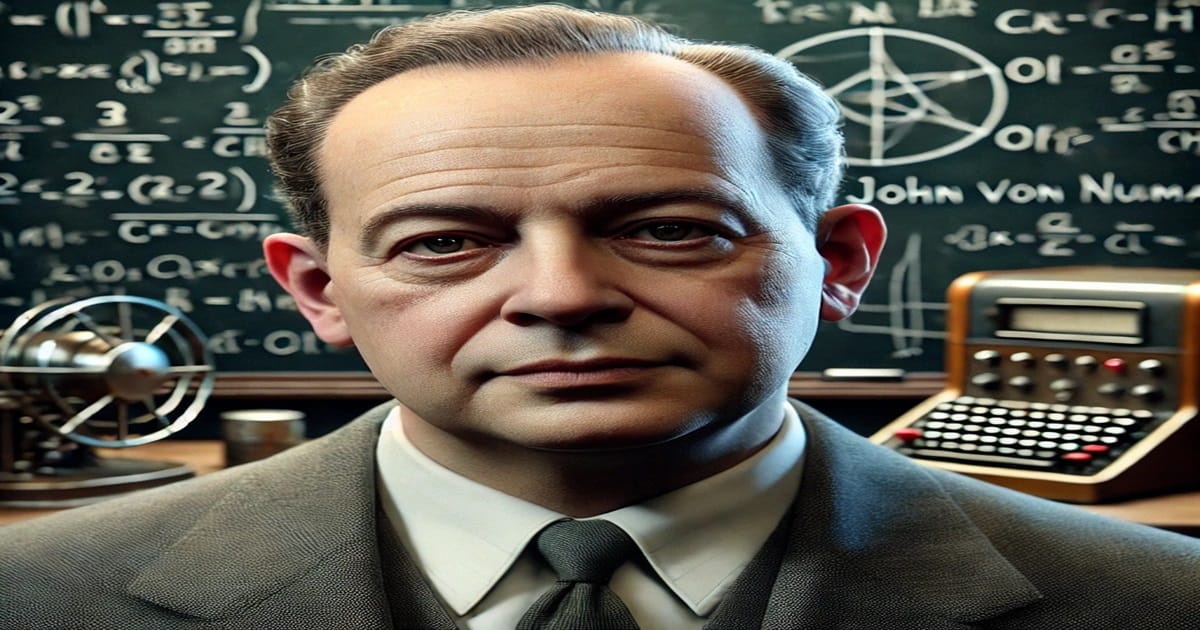4. Cellular Automata & Early AI Aspirations
4.1 Self-Replicating Grids
Von Neumann’s curiosity didn’t end at classical computation. He ventured
into cellular automata, proposing grids of cells that evolve
based on local rules, potentially achieving self-replication. Decades later,
John Conway’s “Game of Life” made such automata famous, but von Neumann’s
theoretical universal constructors prefigured advanced ideas in artificial
life, swarm intelligence, and even self-repairing robotic colonies.
These forays epitomize his broader drive to unify abstract mathematics
with emergent phenomena. By analyzing how local interactions yield
complex global patterns, von Neumann positioned himself as an intellectual
ancestor of modern AI, where local rule-based systems can produce
adaptive, seemingly intelligent outcomes. Whether in distributed
robotics or nanotech, these seeds of emergent computation remain crucial.
4.2 Manhattan Project & Moral Dilemmas
During WWII, von Neumann contributed calculations to the Manhattan Project,
helping refine bomb lens designs. While crucial to ending the war, it also
ushered in the nuclear arms race, underscoring the ethical quagmire
inherent to transformative science. Von Neumann’s confidence in rational
governance spoke to his conviction that logic could tame even potent
weapons. This tension — between scientific progress and moral responsibility —
is still debated, from nuclear disarmament to AI safety protocols.
Even as he worked on nuclear research, von Neumann never lost sight of
science’s potential to drive broader societal benefits. His subsequent
focus on universal computing, weather modeling, and multi-disciplinary
projects reflected a belief that reasoned oversight could amplify
the good in cutting-edge research. The same reprogrammable approach
that drove ballistic calculations, he believed, could just as easily
empower breakthroughs in medicine, commerce, and collaborative problem-solving.
5. Personality and Influence
5.1 A Convivial Scholar
Though lauded as a top-tier mathematician, von Neumann was equally admired
for his humor and sociability. He delighted in dinner parties, merging
lighthearted banter with discussions on nuclear physics, logic puzzles,
or advanced analysis. His photographic memory allowed him to quote entire
texts or spontaneously solve complicated integrals, astonishing colleagues
and building connections across fields.
Married twice — first to Mariette Kövesi, then to Klara Dan — he balanced
a hectic schedule of consulting, academic lecturing, and policy advising
with personal relationships that anchored him. Princeton lore paints him
as a unifying figure, bridging departmental silos and inspiring synergy
among varied researchers. This amiable spirit underscored the importance
of cross-pollination, integral to his success in forging new domains.
5.2 A Life Cut Short
Von Neumann died of cancer in 1957 at the age of 53, cutting short what
might have been even more revolutionary achievements. Nevertheless,
his stored-program blueprint, game-theoretic strategies, quantum formalism,
and advocacy for computational meteorology formed a sturdy bedrock
for countless advances that followed. His passing left a void at
Princeton’s IAS, but his ideas kept evolving through the minds
and labs he inspired, ensuring his legacy transcended his own era.
6. Modern Relevance: From HPC to Mini PCs
Today, the universal architecture von Neumann championed remains the
foundation of computing. Whether it’s a giant HPC (High-Performance
Computing) cluster simulating black hole mergers or a sleek
mini PC delivering 4K media streams, each device
still uses the same fetch-decode-execute logic. Evolving memory standards
such as DDR4 or
DDR5 SDRAM
feed CPUs more data more quickly, mitigating bottlenecks but never
discarding the original re-programmable principle that instructions define
the machine’s function.
In parallel, virtualization and container orchestration in the cloud replicate
this “universal logic” at scale, letting data centers seamlessly run thousands
of different workloads on shared hardware. Von Neumann’s vision of flexible,
software-driven machines endures, bridging HPC labs and personal devices
in a single conceptual framework. The unstoppable synergy between
memory, CPU, and software ensures the stored-program model remains a
cornerstone of digital progress, whether for industrial AI or everyday
consumer tasks.
10+ Tech Inspired and made Possible by Von Neumann–Innovative Mind
- Gaming PC DDR5 Mini PC
- DDR5 32GB Mini PC
- Gaming Mini PC (DDR4 & DDR5)
- Mini PC (In General) DDR4 & DDR5
- BOSGAME B95 DDR4 Mini PC
- Gezoon DDR5 Mini PC (Home/Office)
- Amazon Mini PC (DDR5)
- Amazon Mini PC (DDR4)
- Logitech Wireless Mechanical Keyboard
- NordVPN
- Turbo-Speed Hosting
Discover the synergy between DDR5 and mini PCs in
Modern DDR5 Mini PC is an Amazing Choice
,
or compare form factors at
Mini PC Vs Laptops: A Comprehensive Analysis
.
7. Frequently Asked Questions
7.1 Was Von Neumann the Sole Inventor of Modern Computing?
No. Other pioneers, including Alan Turing, Konrad Zuse, and Howard Aiken, each contributed
essential insights. Von Neumann’s genius lay in synthesizing these ideas into the
stored-program concept, catalyzing universal machine designs
that soared from specialized labs into every aspect of society.
7.2 How Did He Impact Gaming Computers?
Modern gaming computers
rely on the same universal principle, allowing software-driven transformations between
various gaming genres, real-time physics, and GPU-based 3D rendering.
Von Neumann’s architectural logic empowers these systems to pivot from eSports titles
to productivity tasks through nothing more than software changes, all built atop
that fundamental memory-and-instruction unification.
7.3 What Is the “Von Neumann Bottleneck”?
Because instructions and data share the same memory bus, throughput can become a bottleneck.
Caching layers, branch prediction, and out-of-order execution alleviate some slowdown.
Nevertheless, the conceptual simplicity — one memory for instructions and data —
keeps mainstream computing consistent and adaptable, aligning with von Neumann’s
vision of flexible designs.
7.4 How Do DDR4 vs. DDR5 Memory Fit In?
In a von Neumann system, faster memory directly benefits the CPU’s instruction feed,
reducing idle cycles.
DDR4 SDRAM
DDR4 Mini PC
and its successor,
DDR5 SDRAM,
are evolutionary steps boosting bandwidth and capacity. Higher-speed RAM helps feed
modern multi-core processors, mitigating some performance hits from the
“von Neumann bottleneck” and enabling intense tasks like 4K gaming,
AI model training, and large-scale data analytics.
7.5 Did He Work on the Manhattan Project?
Yes. Von Neumann’s computations helped design lens configurations for the first nuclear bombs,
exemplifying how advanced science can serve both constructive and destructive goals.
Although he recognized the dangers, he believed rational oversight would harness
technology for net good. This duality — fostering leaps in computing while fueling
an arms race — underscores the moral complexities that still shape high-tech research.
8. Conclusion: A Legacy That Defines Modern Tech
John von Neumann’s life story embodies the power of interdisciplinary insight.
His stored-program concept — letting instructions reside in memory alongside data —
revolutionized computing forever, enabling devices to transform roles at the speed of
software. This universal model still guides everything from supercomputers analyzing
global weather to a petite mini PC streaming your favorite shows.
Likewise, his expansions into quantum mechanics, game theory, and advanced meteorology
demonstrate an unrelenting curiosity anchored by rigorous math and an unwavering
desire to improve the world through logic and rational planning.
Even decades after his premature death, we feel von Neumann’s impact.
HPC simulations for climate research, universal frameworks for AI strategy,
and memory innovations (like DDR4 and DDR5) that propel new levels of performance
all resonate with his core vision: that computing’s real magic is in its ability
to be reprogrammed at will. As emerging paradigms like neuromorphic hardware
and quantum processors take root, the spirit of universal machines
he championed continues to guide and inspire, reaffirming John von Neumann’s
place as the “Father of the Great Computer Age.”
For more on his extraordinary life, achievements, and forward-thinking
in multiple domains, visit
Wikipediiai>John_von_Neumann
.





